Blue Victorian house colors represent one of the most sophisticated and historically significant color palettes in architectural history. During the Victorian era spanning from 1837 to 1901, blue pigments became increasingly available and popular for exterior home decoration. These rich, saturated hues were carefully chosen to highlight the ornate architectural details characteristic of Victorian homes, from intricate gingerbread trim to elaborate bay windows. The period's technological advances in pigment production introduced revolutionary colors like Prussian blue, while traditional favorites evolved into deeper, more dramatic shades. Understanding these authentic blue Victorian house colors helps homeowners restore period properties or create historically-inspired designs that honor this remarkable architectural legacy.
1. Prussian Blue Victorian House Color

Prussian blue stands as the most revolutionary blue Victorian house color, accidentally discovered by paint maker Johann Jacob Diesbach in Berlin around 1706. This deep, saturated blue became the first modern synthetic pigment and quickly replaced expensive lapis lazuli-based paints. Victorian homeowners embraced Prussian blue for its intense, stable color that wouldn't fade in sunlight. The pigment's rich, almost black-blue appearance made it perfect for highlighting ornate Victorian architectural details like decorative brackets and carved moldings. When used on Victorian house exteriors, Prussian blue creates a dramatic, sophisticated appearance that captures the era's preference for bold, dignified colors. This historically significant shade remains popular today for authentic Victorian restoration projects.
2. Midnight Blue Victorian House Color
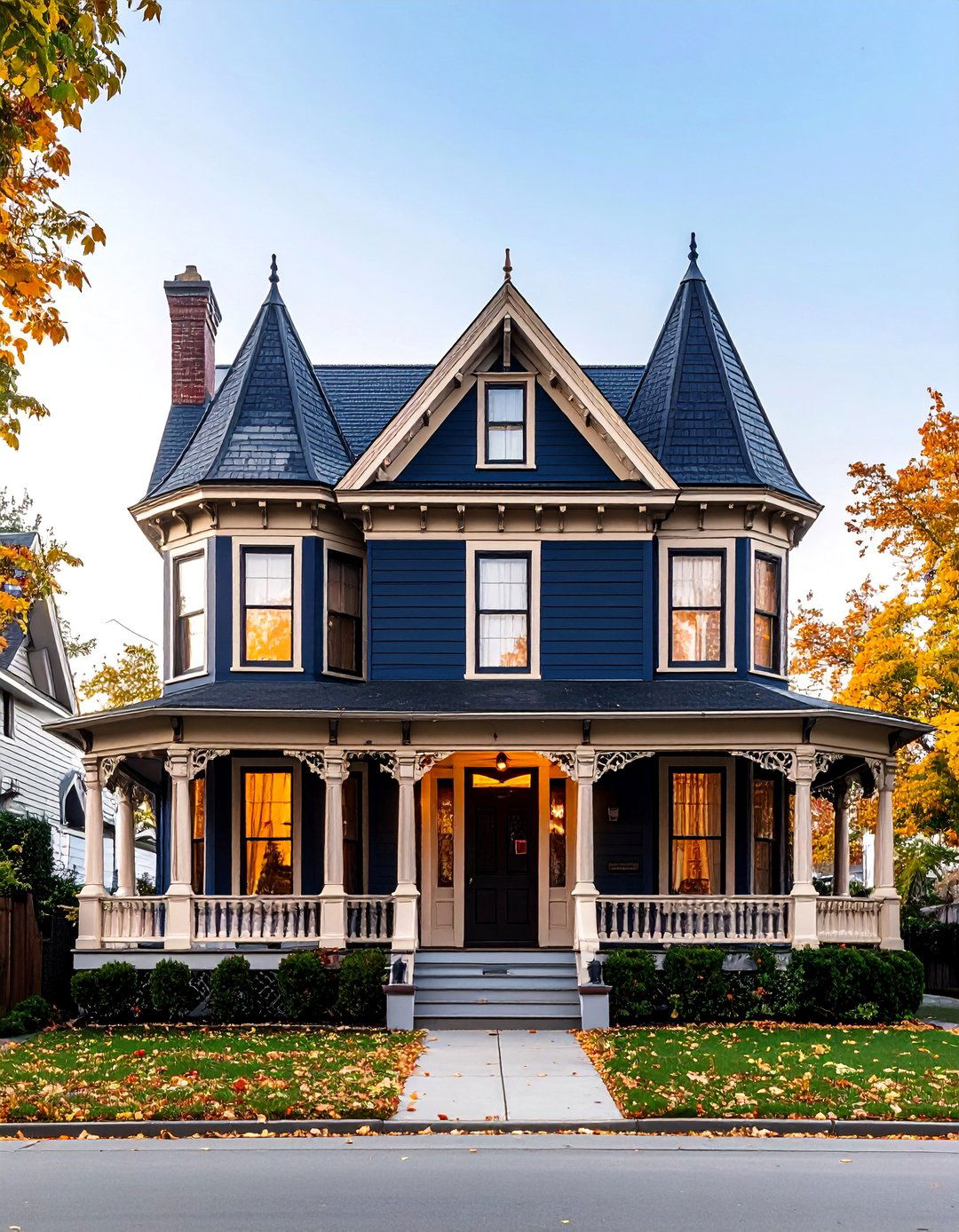
Midnight blue Victorian house color emerged as one of the darkest and most mysterious shades used during the period. This deep, almost black-blue hue resembles the night sky and was originally called Prussian blue before Crayola renamed it in 1958. Victorian homeowners favored midnight blue for its elegant, sophisticated appearance that complemented the era's ornate architectural features. The color's depth made it ideal for larger Victorian homes where dramatic impact was desired. When applied to Victorian house exteriors, midnight blue creates a striking contrast against white or cream trim, emphasizing decorative elements like turrets, bay windows, and elaborate porches. This timeless shade continues to be chosen by homeowners seeking authentic Victorian elegance with contemporary appeal.
3. Navy Blue Victorian House Color

Navy blue Victorian house color represented the period's association with maritime power and British naval strength. This deep, rich blue shade gained popularity during the mid-Victorian era when the British Empire was at its height. Victorian homeowners chose navy blue to convey stability, prosperity, and patriotic sentiment. The color's versatility made it suitable for various Victorian architectural styles, from Gothic Revival to Italianate designs. Navy blue Victorian house exteriors were often paired with contrasting trim colors like gold, cream, or white to highlight intricate woodwork and decorative details. This classic shade provided a sophisticated backdrop that enhanced the complex color schemes typical of Victorian homes, often serving as the dominant color in three or four-color palettes.
4. Powder Blue Victorian House Color
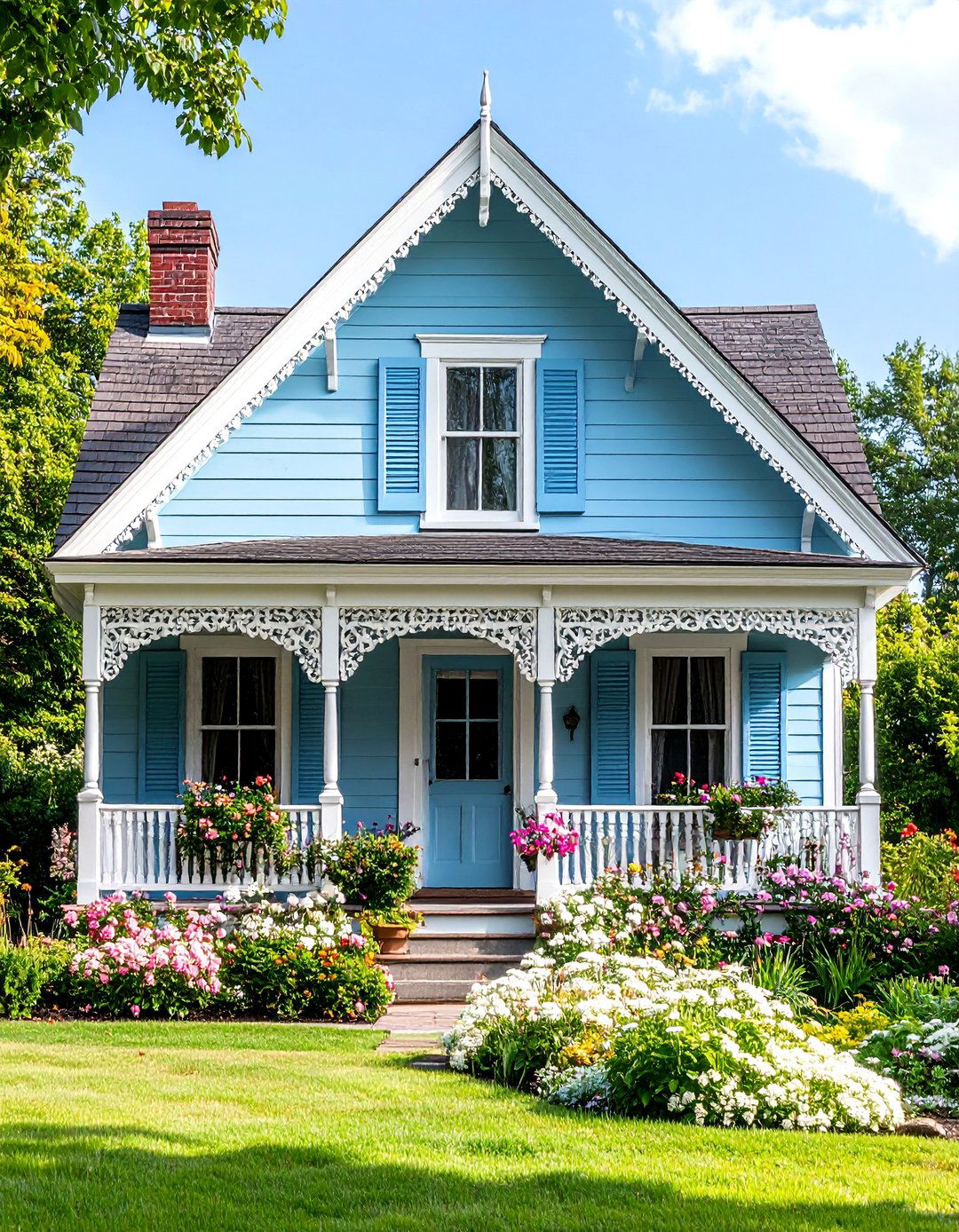
Powder blue Victorian house color offered a softer alternative to the era's typically bold palette. This delicate, pastel blue shade was discovered in historic Victorian interiors and noted in period paint reference catalogues. Powder blue provided Victorian homeowners with a genteel, refined option that still maintained the period's preference for distinctive colors. The shade's subtle nature made it perfect for smaller Victorian cottages or homes in residential areas where a more understated appearance was desired. When used on Victorian house exteriors, powder blue created a calming, welcoming presence while still honoring historical authenticity. This versatile color worked beautifully with the white or cream trim typical of Victorian architecture, creating harmonious color schemes that highlighted architectural details without overwhelming them.
5. Periwinkle Blue Victorian House Color
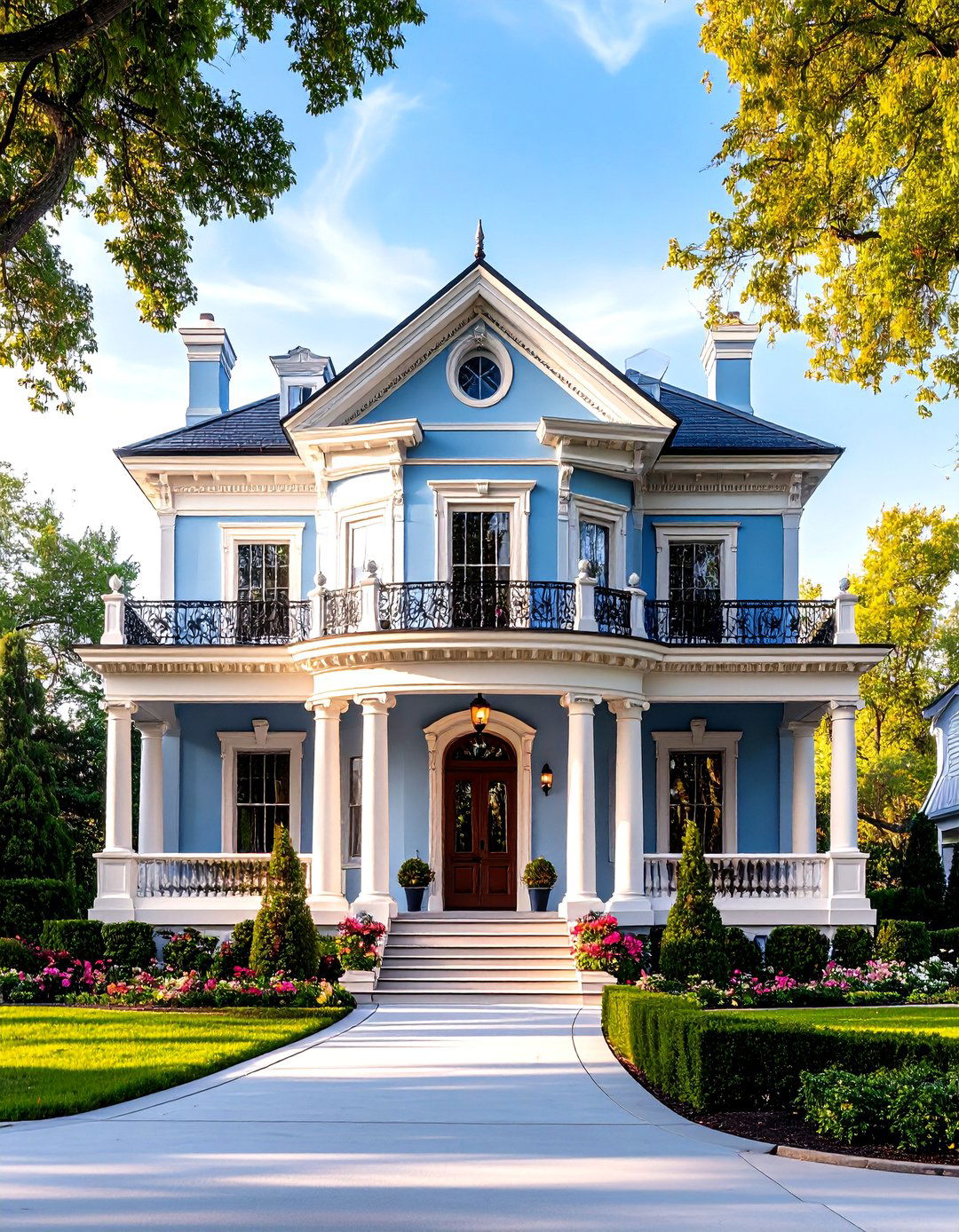
Periwinkle blue Victorian house color emerged as a light, sophisticated option discovered in historic Victorian mansions. This grayish-blue shade, identified in the historic Fallon House and Meek Mansion, exemplified the period's appreciation for complex, nuanced colors. Periwinkle blue offered Victorian homeowners a refined choice that balanced the era's preference for distinctive colors with a more subtle approach. The color's gentle appearance made it particularly suitable for Italianate Victorian architecture, where its soft tones complemented the style's classical proportions. When applied to Victorian house exteriors, periwinkle blue created an elegant, timeless appearance that enhanced architectural details without competing with ornate decorative elements. This historically authentic shade continues to appeal to homeowners seeking Victorian character with contemporary sensibility.
6. Steel Blue Victorian House Color
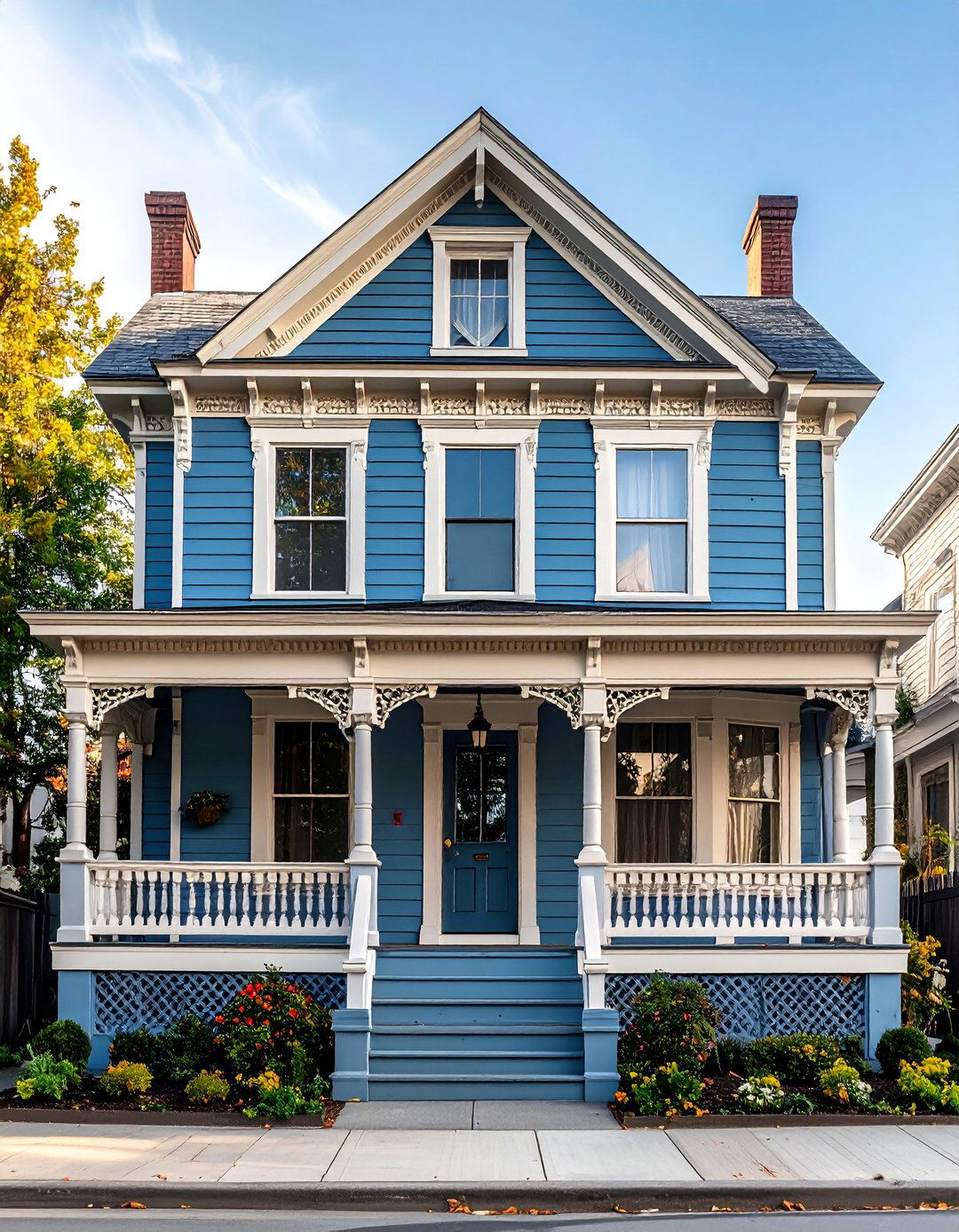
Steel blue Victorian house color represented the industrial age's influence on residential architecture. This muted, grayish-blue shade reflected the period's fascination with technological progress and modern manufacturing. Victorian homeowners appreciated steel blue's sophisticated, understated elegance that conveyed prosperity without ostentation. The color's neutral qualities made it versatile for various Victorian architectural styles while maintaining the period's preference for distinctive, non-neutral colors. Steel blue Victorian house exteriors created a modern, progressive appearance that aligned with the era's forward-thinking spirit. When paired with white or cream trim, this color highlighted intricate Victorian details like decorative brackets, carved bargeboards, and ornate porch railings. Steel blue's timeless appeal makes it an excellent choice for contemporary homeowners seeking authentic Victorian character with lasting style.
7. Slate Blue Victorian House Color
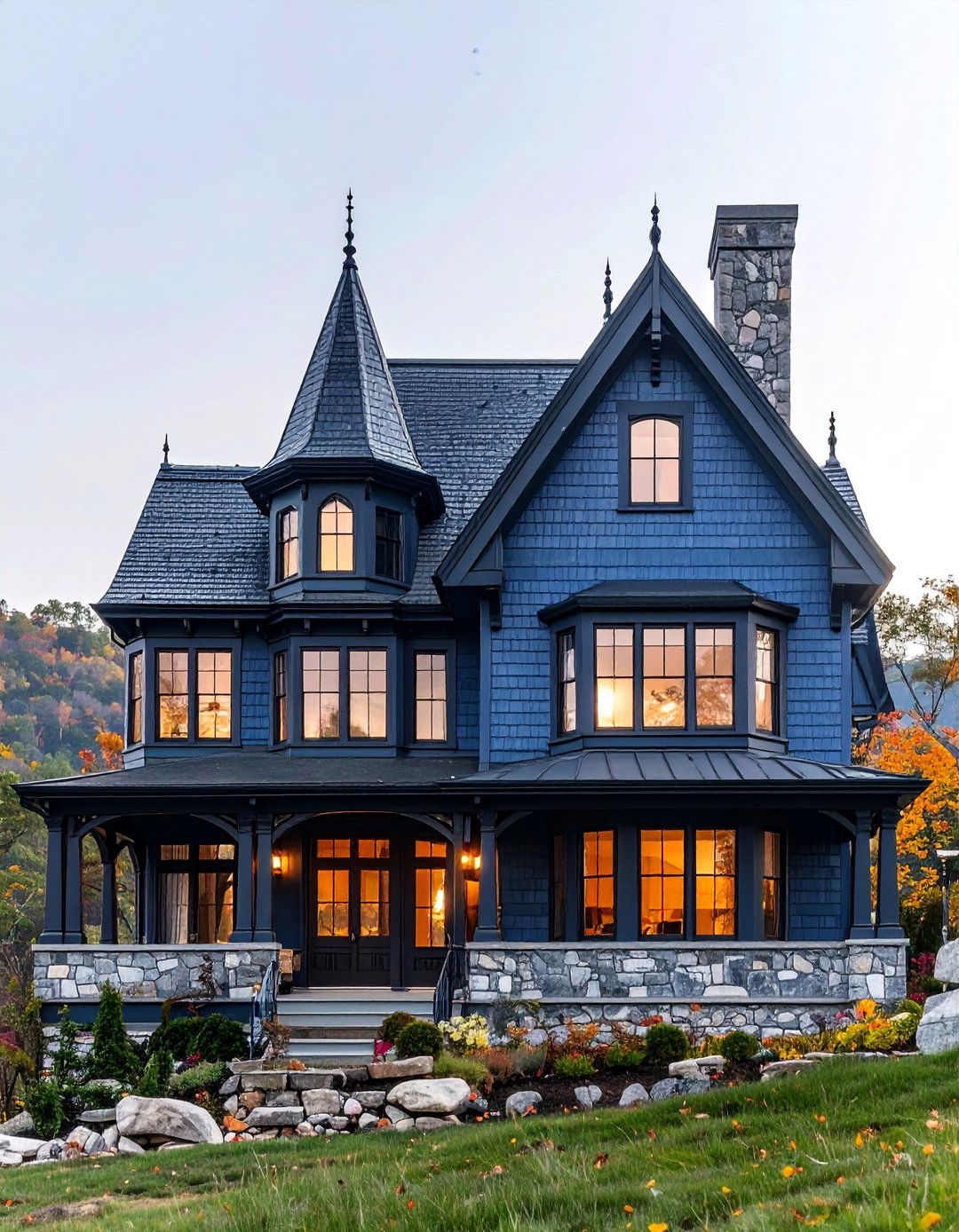
Slate blue Victorian house color embodied the period's appreciation for sophisticated, understated elegance. This blue-gray shade drew inspiration from natural slate materials commonly used in Victorian construction and roofing. Victorian homeowners chose slate blue for its refined appearance that complemented the era's preference for earthy, dignified colors. The color's subtle gray undertones made it particularly suitable for Gothic Revival Victorian homes, where its muted tones enhanced pointed arches and decorative stonework details. Slate blue Victorian house exteriors created a harmonious relationship with natural surroundings while maintaining historical authenticity. When combined with darker trim colors, this shade highlighted architectural features without overwhelming ornate details. Slate blue's versatile nature allows it to work beautifully with various complementary colors in traditional Victorian multi-hue schemes.
8. Cornflower Blue Victorian House Color
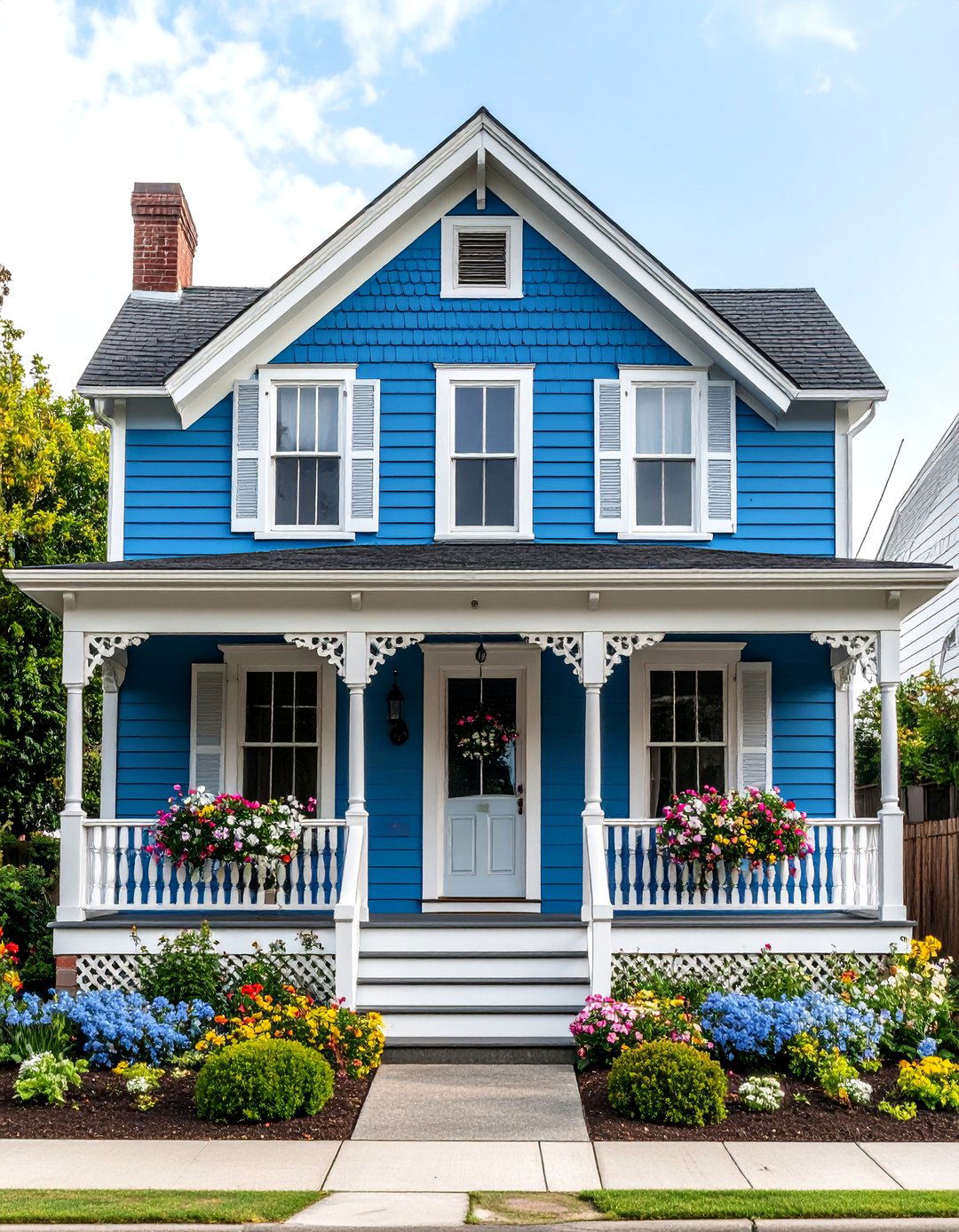
Cornflower blue Victorian house color brought a cheerful, medium-light shade to the period's color palette. This vibrant blue hue was favored by Victorian homeowners who desired a more optimistic, welcoming appearance for their homes. The color's natural inspiration from cornflower blooms aligned with the Victorian era's appreciation for botanical themes and garden influences. Cornflower blue created an inviting, friendly atmosphere that balanced the period's preference for dramatic colors with approachable charm. When used on Victorian house exteriors, this shade worked particularly well with Queen Anne style architecture, where its lively character complemented asymmetrical designs and decorative shingle patterns. Cornflower blue paired beautifully with white, cream, or soft yellow trim colors, creating color schemes that highlighted Victorian architectural details while maintaining the era's characteristic multi-color approach to exterior decoration.
9. Heritage Blue Victorian House Color

Heritage blue Victorian house color represents an aged, weathered shade documented in historic Victorian era paint references. This distinctive blue shows the natural patina that authentic Victorian colors developed over time, creating an authentically vintage appearance. Victorian homeowners originally chose this type of blue for its sophisticated, mature character that conveyed established prosperity and refined taste. Heritage blue's weathered quality made it perfect for larger Victorian homes where a sense of gravitas and permanence was desired. When applied to Victorian house exteriors today, heritage blue creates an authentic period appearance that honors the natural aging process of historical paints. This color works exceptionally well with traditional Victorian trim colors like cream or white, highlighting ornate architectural details while maintaining the understated elegance that characterized well-established Victorian households during the era's later periods.
10. Bidwell Blue Victorian House Color
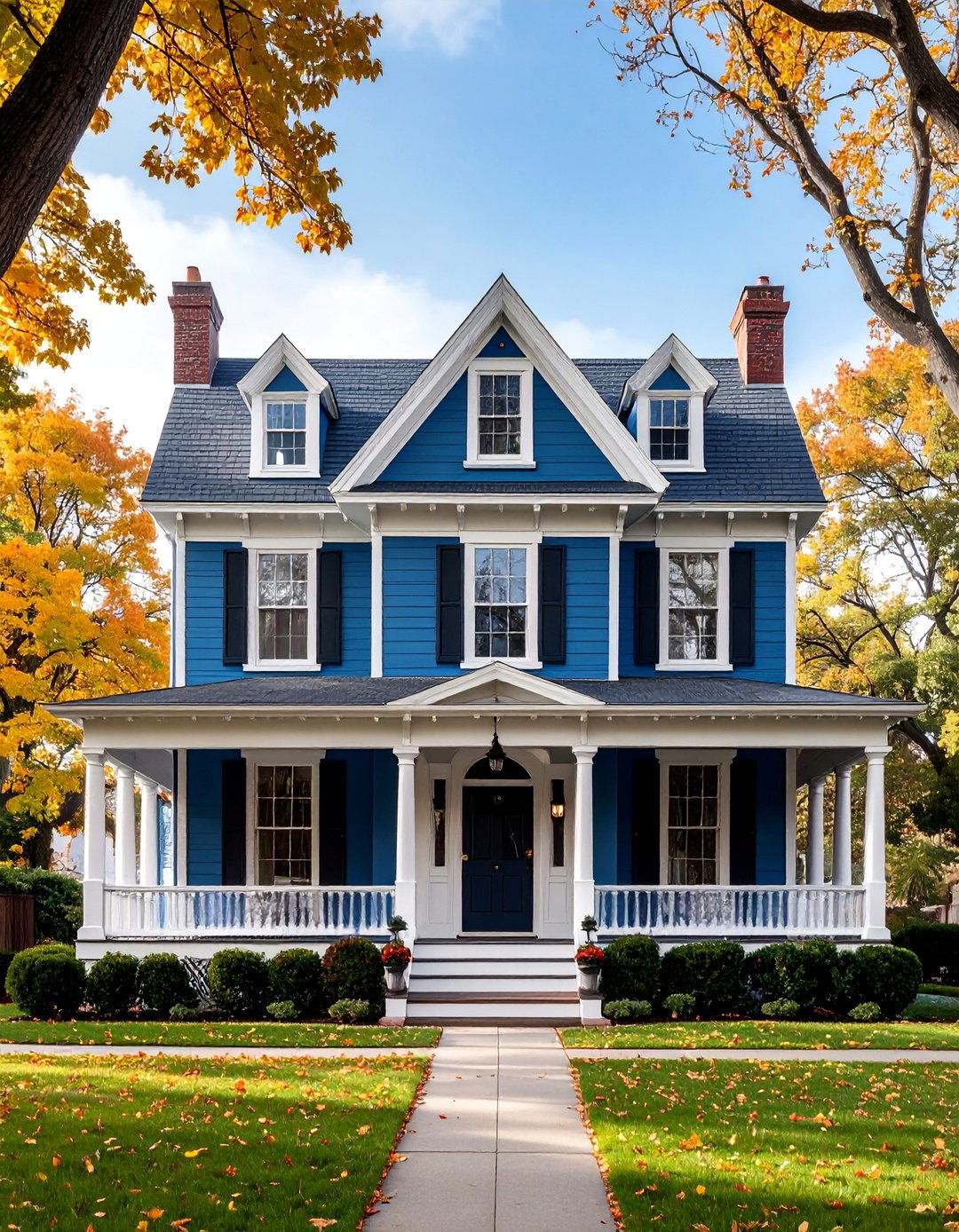
Bidwell blue Victorian house color takes its name from the historic Bidwell Mansion, a Victorian-Italianate building constructed in 1865 in Chico, California. This grayed and worn, soft aged blue exemplifies authentic Victorian interior colors that were also applied to exterior applications. The shade's discovery in this significant Victorian structure provides direct historical evidence of period color choices. Bidwell blue offers a gentle, sophisticated alternative to bolder Victorian blues while maintaining historical authenticity. Victorian homeowners appreciated this type of muted blue for its refined, established appearance that suggested prosperity and good taste. When used on Victorian house exteriors, Bidwell blue creates a distinguished, timeless look that complements intricate architectural details without overwhelming them. This historically documented shade provides contemporary homeowners with confidence in choosing an authentically Victorian color for restoration or period-inspired projects.
11. Avalon Blue Victorian House Color
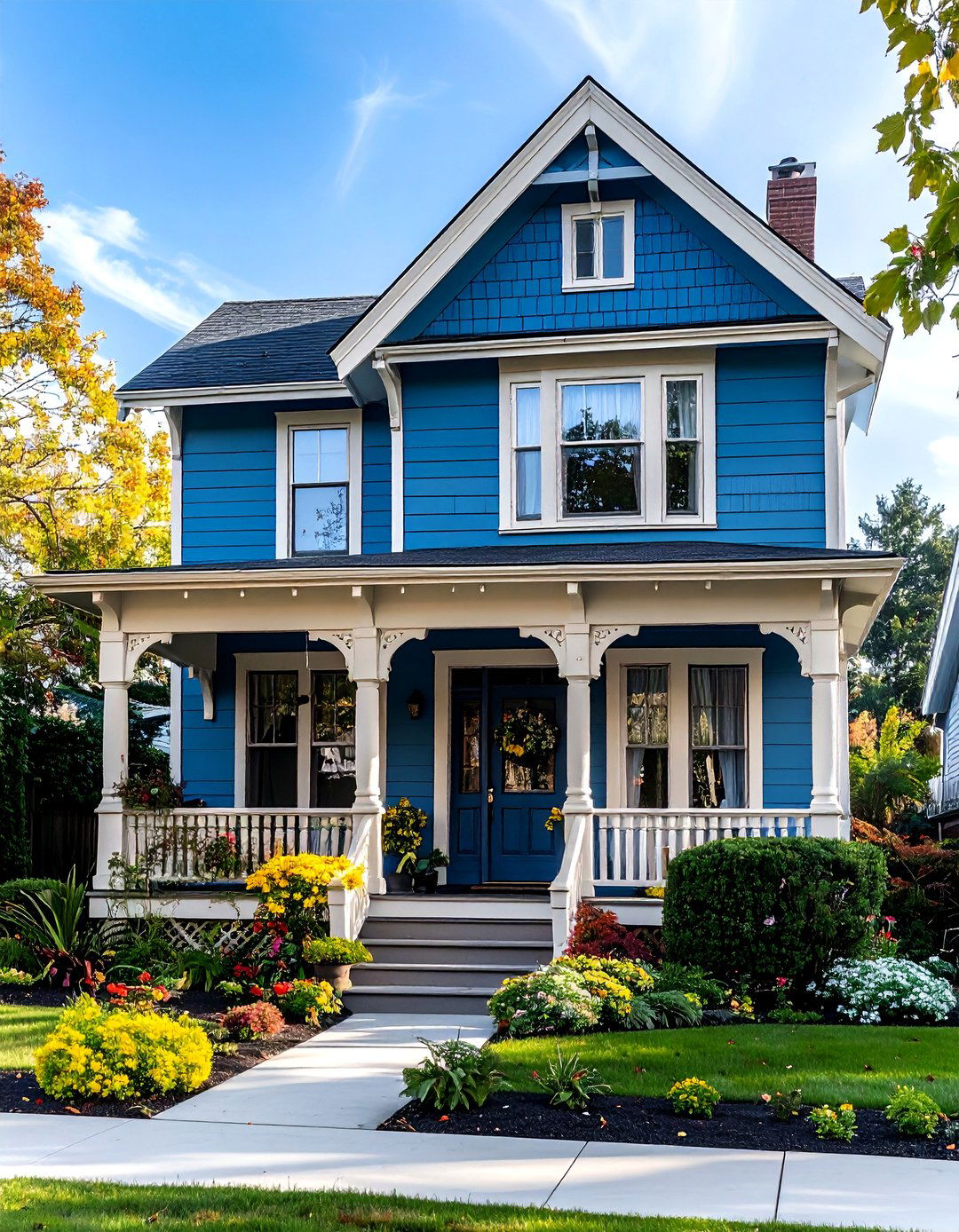
Avalon blue Victorian house color represents a powdered, midtone, watery blue identified in the historic Fallon House and documented in Victorian era paint catalogues. This distinctive shade exemplifies the period's preference for complex, nuanced colors that created sophisticated architectural presentations. Avalon blue's ethereal quality made it particularly appealing to Victorian homeowners who desired elegance without overwhelming boldness. The color's watery appearance created a sense of tranquility and refinement that aligned with Victorian sensibilities about proper domestic presentation. When applied to Victorian house exteriors, Avalon blue provides a serene, distinguished appearance that enhances architectural details through subtle contrast. This historically authentic shade works beautifully with white or cream trim, creating the type of harmonious color schemes that Victorian homeowners favored. Avalon blue's documented provenance makes it an excellent choice for accurate historical restoration projects.
12. Bell Blue Victorian House Color
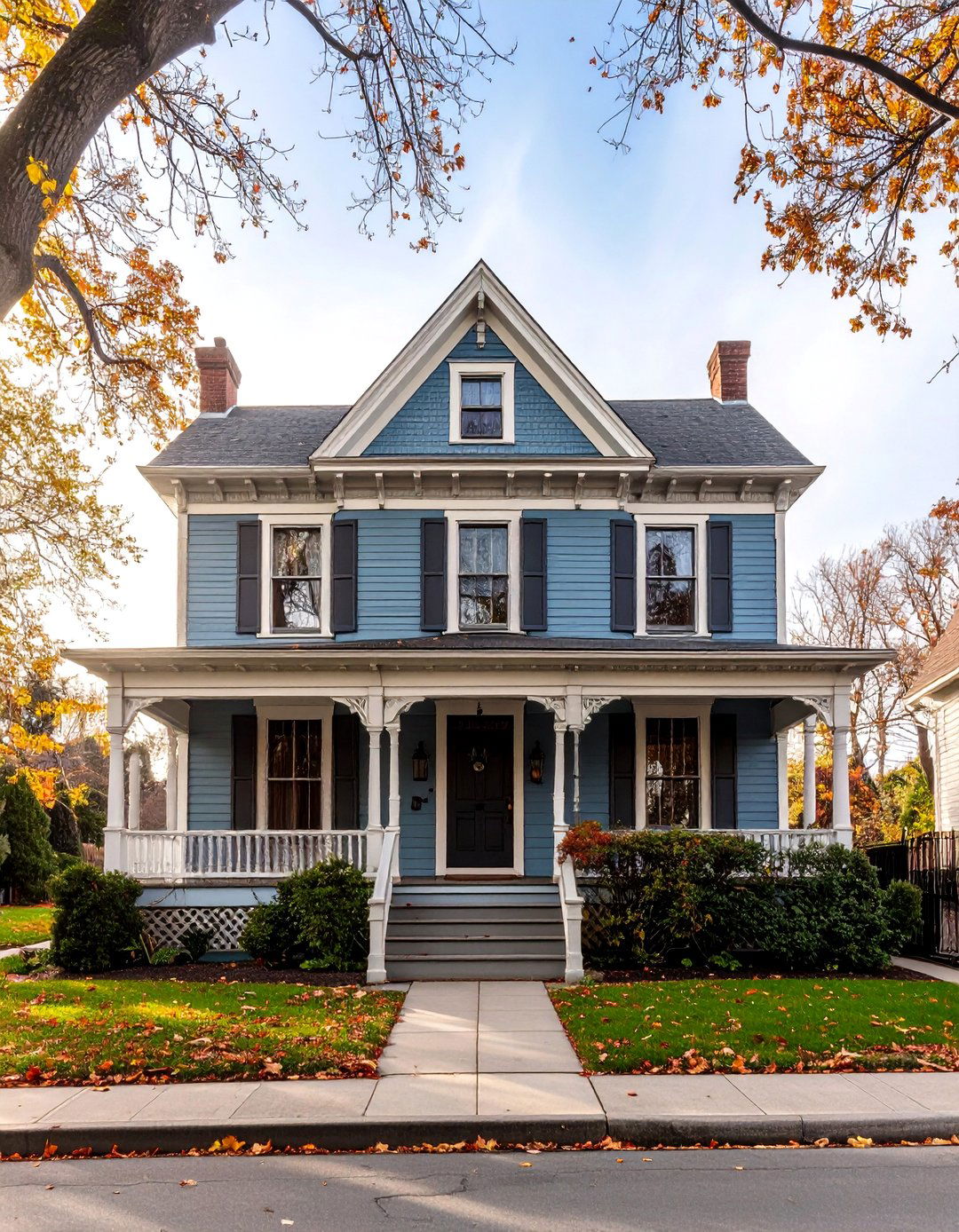
Bell blue Victorian house color originated from the historic Bell House, a Victorian-Stick style home built in 1883. This stone blue shade represents the authentic colors discovered during historical paint analysis of significant Victorian structures. The color's stone-like quality reflected the Victorian era's appreciation for natural materials and earth-inspired tones. Bell blue offered homeowners a sophisticated, grounded color choice that maintained the period's preference for distinctive, non-neutral shades. Victorian homeowners valued this type of blue for its substantial, permanent appearance that conveyed stability and prosperity. When used on Victorian house exteriors, Bell blue creates a dignified, enduring presentation that complements the era's ornate architectural features. This historically documented shade provides excellent authenticity for Victorian restoration projects while offering contemporary appeal. Bell blue's natural stone character makes it particularly suitable for Victorian homes with mixed material construction.
13. Aquamarine Victorian House Color
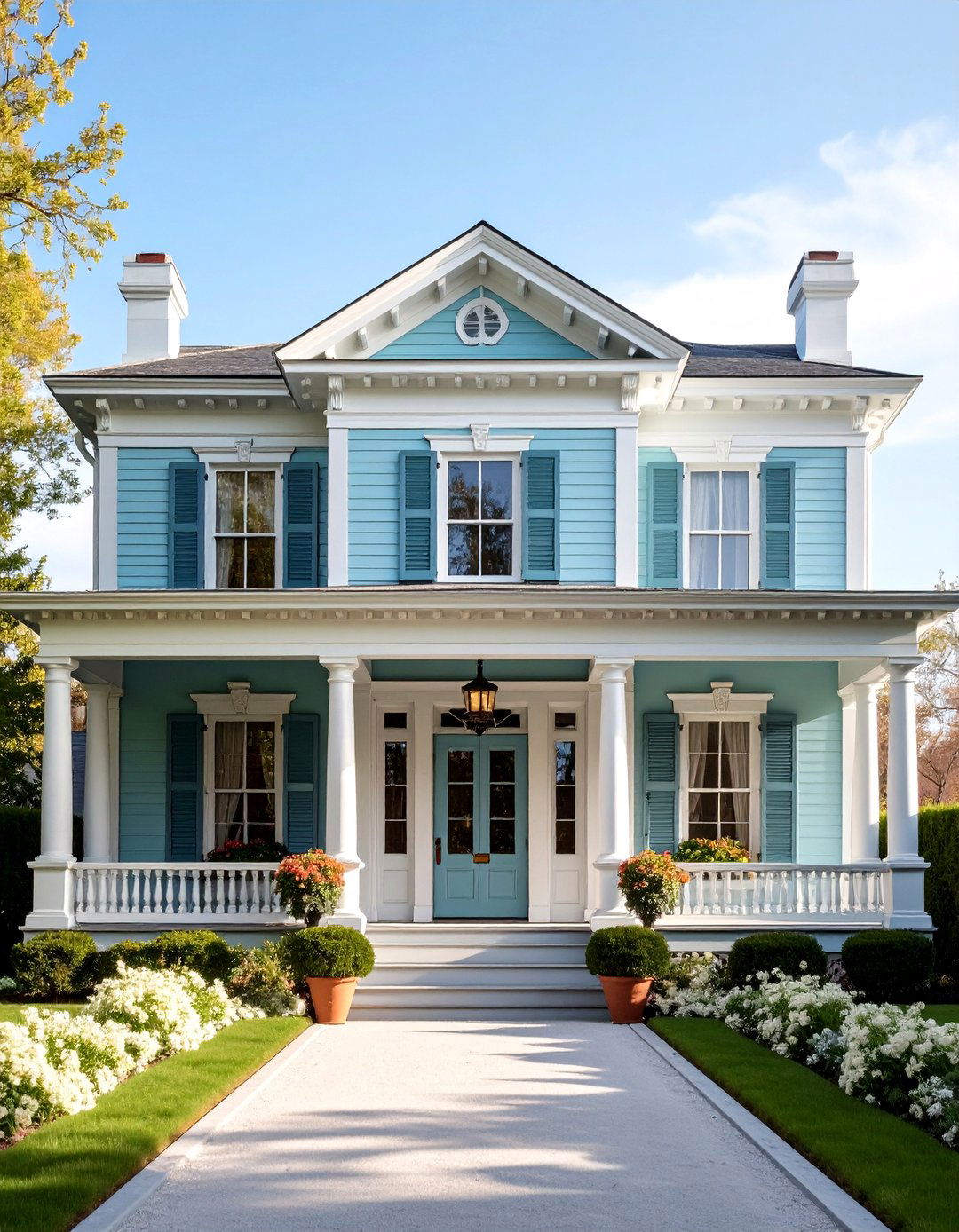
Aquamarine Victorian house color represents a spa blue tinted white discovered in the historic Alta Mira Club and Fallon House, both exemplary Italianate architecture examples. This whisper-light blue offered Victorian homeowners a delicate, refined color choice that maintained historical authenticity while providing subtle elegance. The shade's gentle nature made it particularly suitable for Victorian homes where understated sophistication was desired over dramatic boldness. Aquamarine's pale, ethereal quality created a sense of serenity and refinement that aligned with Victorian ideals of proper domestic presentation. When applied to Victorian house exteriors, aquamarine provides a peaceful, welcoming appearance that enhances architectural details through gentle contrast rather than bold statement. This historically documented shade works beautifully in Victorian color schemes that emphasize harmony and balance. Aquamarine's authentic provenance from significant Victorian structures makes it an excellent choice for accurate period restoration.
14. Lake Reflection Blue Victorian House Color
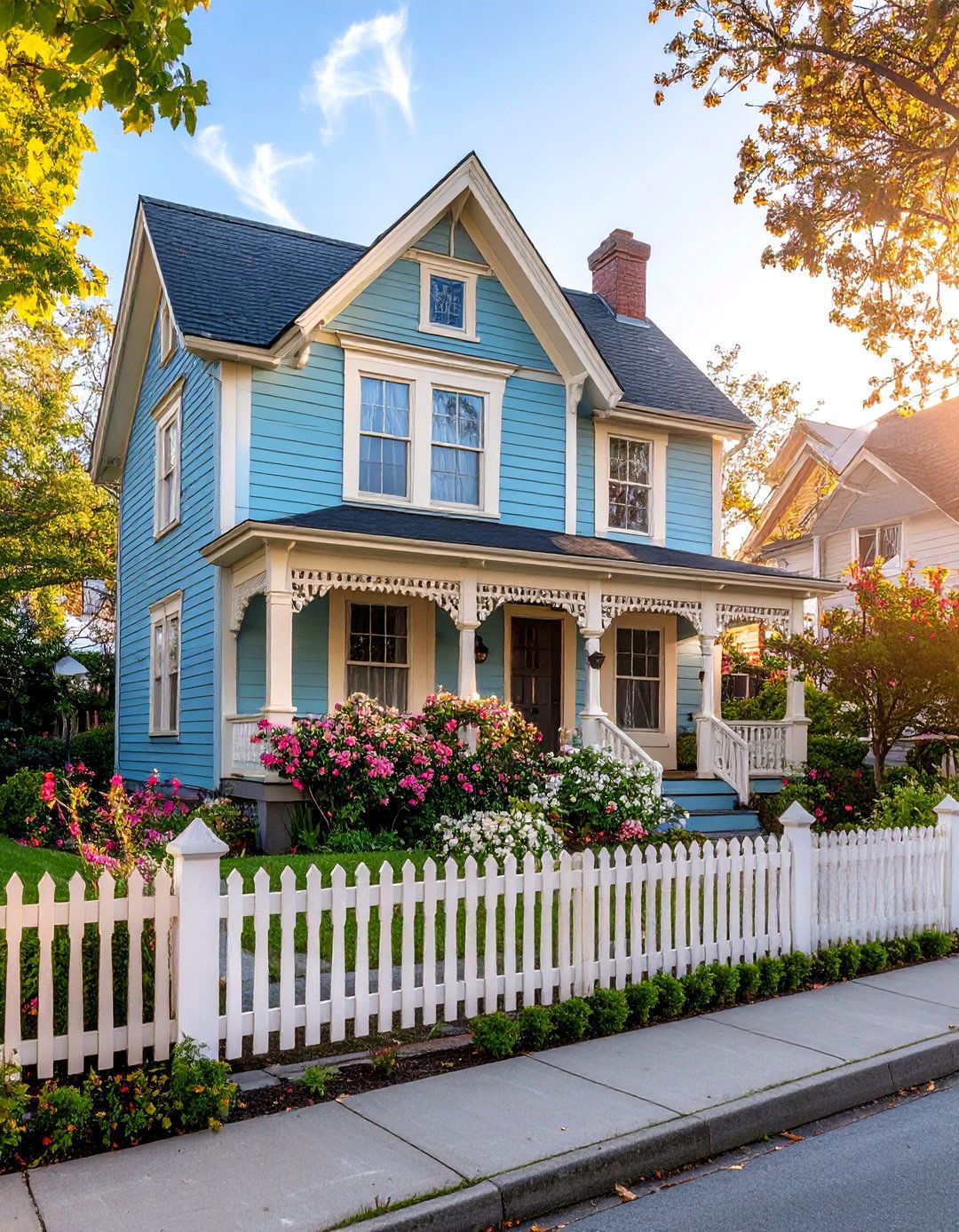
Lake Reflection blue Victorian house color represents a bright, clear pastel blue documented in historic Victorian era paint references as "Piazza Blue." This luminous shade exemplified the period's appreciation for colors that captured natural phenomena and scenic beauty. Victorian homeowners chose Lake Reflection blue for its optimistic, uplifting character that created welcoming, approachable home exteriors. The color's clarity and brightness made it particularly suitable for Victorian cottages and smaller homes where cheerful charm was desired. When applied to Victorian house exteriors, Lake Reflection blue creates a fresh, inviting appearance that highlights architectural details through gentle contrast. This historically authentic shade works exceptionally well with white or cream trim, creating the harmonious color relationships that Victorian homeowners favored. Lake Reflection blue's documented heritage and appealing character make it perfect for homeowners seeking authentic Victorian colors with contemporary charm.
15. Ragtime Blues Victorian House Color

Ragtime Blues Victorian house color represents a deep, blackened blue documented in historic Victorian era paint references as "Pure Blue" by John W. Masury & Son. This intense shade exemplified the period's preference for bold, dramatic colors that made strong architectural statements. Victorian homeowners chose Ragtime Blues for its sophisticated, mysterious character that conveyed prosperity and refined taste. The color's depth and richness made it particularly suitable for larger Victorian homes where dramatic impact was desired. When applied to Victorian house exteriors, Ragtime Blues creates a striking, memorable presentation that emphasizes ornate architectural details through bold contrast. This historically documented shade works beautifully with lighter trim colors like cream or white, creating the type of high-contrast relationships that Victorian color schemes favored. Ragtime Blues' authentic heritage and commanding presence make it ideal for homeowners seeking dramatic Victorian character with historical accuracy.
16. Blue Velvet Victorian House Color
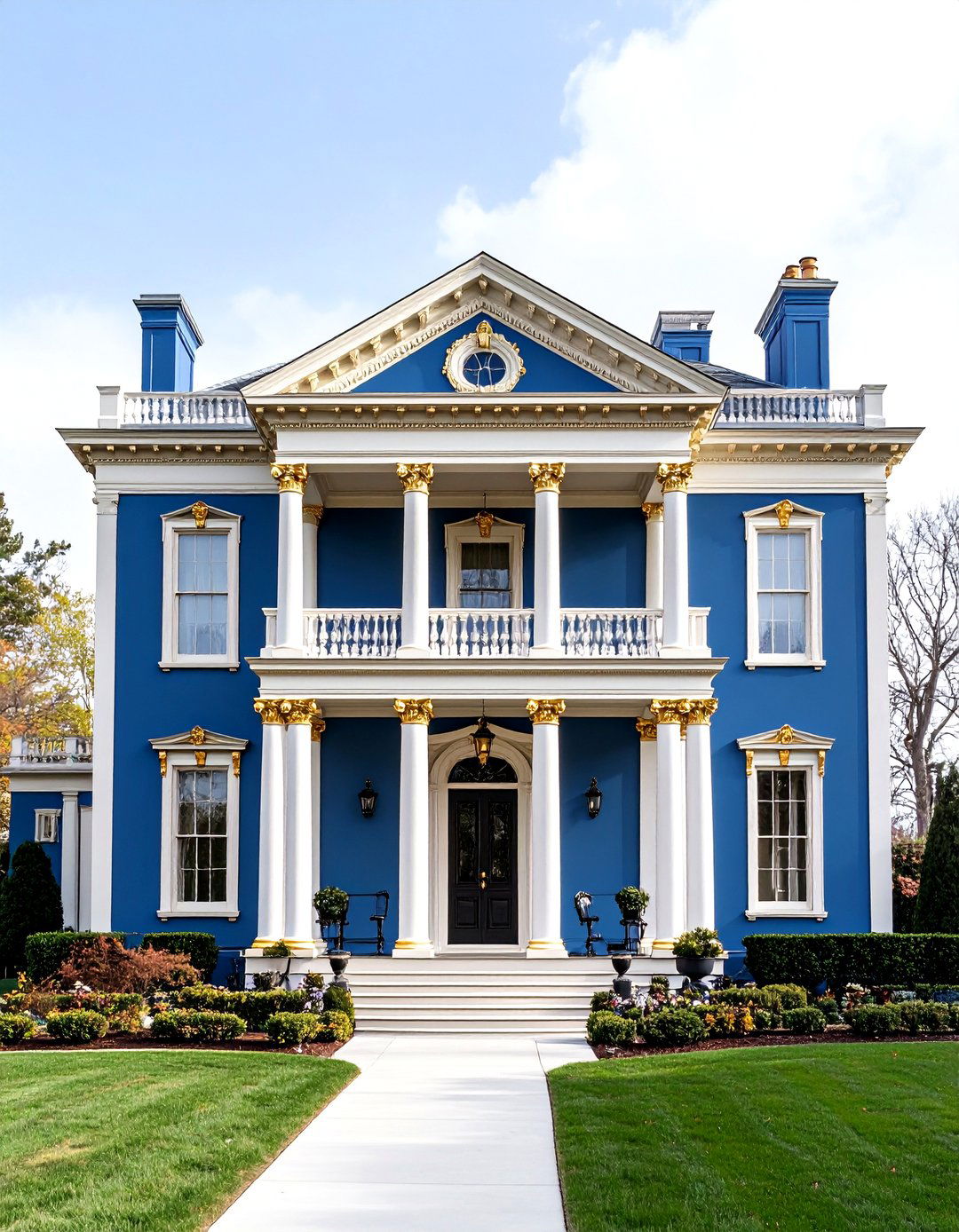
Blue Velvet Victorian house color represents authentic Prussian blue documented in the historic Victorian era Harrison Bros & Co Town & Country color card. This rich, luxurious shade exemplified the period's appreciation for colors that suggested opulence and refined taste. Victorian homeowners valued Blue Velvet for its sophisticated, aristocratic character that conveyed established prosperity and cultural refinement. The color's depth and intensity made it particularly suitable for grand Victorian homes where impressive presentation was essential. When applied to Victorian house exteriors, Blue Velvet creates a regal, distinguished appearance that highlights elaborate architectural details through dramatic contrast. This historically documented shade works exceptionally well with gold, cream, or white trim colors, creating the type of elegant color relationships that characterized high-style Victorian residences. Blue Velvet's authentic provenance and commanding presence make it perfect for homeowners seeking prestigious Victorian character with historical authenticity.
17. San Miguel Blue Victorian House Color

San Miguel blue Victorian house color represents a wintry, storm-churning blue documented in historic Victorian era paint references as wagon paint. This dramatic shade exemplified the period's appreciation for colors that captured natural phenomena and atmospheric conditions. Victorian homeowners chose San Miguel blue for its powerful, dynamic character that created memorable architectural presentations. The color's stormy quality made it particularly suitable for Victorian homes in dramatic settings where bold character was desired. When applied to Victorian house exteriors, San Miguel blue creates a striking, weather-worn appearance that suggests permanence and strength. This historically authentic shade works beautifully with contrasting trim colors, creating the type of bold color relationships that Victorian homeowners favored for emphasizing architectural details. San Miguel blue's documented heritage and dramatic character make it ideal for homeowners seeking distinctive Victorian colors with authentic historical provenance and contemporary impact.
18. Jazz Age Blues Victorian House Color
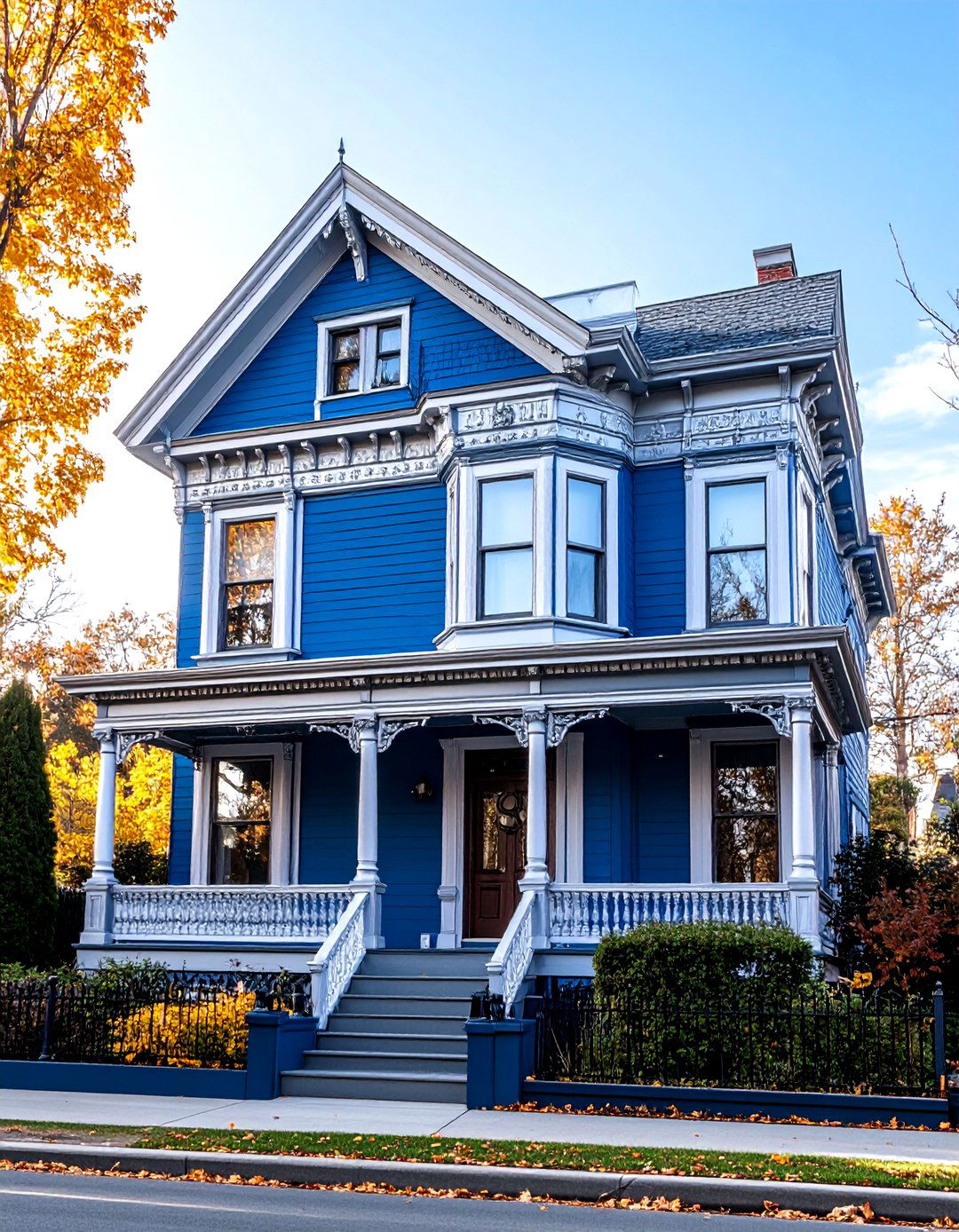
Jazz Age Blues Victorian house color represents a classic, deep rich blue documented in historic Victorian era paint catalogues as "Pure Blue." This sophisticated shade bridged the Victorian and early modern periods, representing the era's evolution toward bolder, more expressive color choices. Victorian homeowners appreciated Jazz Age Blues for its refined yet progressive character that suggested cultural sophistication and forward-thinking attitudes. The color's richness and depth made it particularly suitable for Victorian homes where distinguished presentation was essential. When applied to Victorian house exteriors, Jazz Age Blues creates an elegant, timeless appearance that enhances architectural details through substantial contrast. This historically documented shade works exceptionally well with white, cream, or metallic trim colors, creating color schemes that highlight Victorian ornamental features. Jazz Age Blues' authentic heritage and enduring appeal make it perfect for homeowners seeking classic Victorian character with lasting style.
19. Clematis Blue Victorian House Color

Clematis blue Victorian house color represents a blackened, indigo blue documented in historic Victorian era paint references as "Deep Blue" carriage paint. This intense shade exemplified the period's preference for colors that suggested luxury and refined taste through their association with fine carriages and quality craftsmanship. Victorian homeowners chose Clematis blue for its sophisticated, aristocratic character that conveyed established prosperity and cultural refinement. The color's deep indigo qualities made it particularly suitable for grand Victorian homes where impressive, lasting presentation was essential. When applied to Victorian house exteriors, Clematis blue creates a distinguished, memorable appearance that emphasizes elaborate architectural details through bold, dramatic contrast. This historically documented shade works beautifully with lighter trim colors like cream or white, creating the type of striking color relationships that characterized prestigious Victorian residences. Clematis blue's authentic provenance makes it ideal for accurate restoration projects.
20. Maritime Blue Victorian House Color

Maritime blue Victorian house color represents a light, periwinkle blue discovered in the historic Fallon House and Meek Mansion, both exceptional examples of Italianate Victorian architecture. This gentle shade exemplified the period's appreciation for colors that suggested refinement and cultural sophistication while maintaining approachable elegance. Victorian homeowners valued Maritime blue for its serene, distinguished character that created welcoming yet refined home presentations. The color's soft periwinkle qualities made it particularly suitable for Victorian homes where understated elegance was preferred over dramatic boldness. When applied to Victorian house exteriors, Maritime blue creates a peaceful, timeless appearance that enhances architectural details through gentle, harmonious contrast. This historically documented shade works exceptionally well with white or cream trim, creating the type of balanced color relationships that Victorian homeowners favored. Maritime blue's authentic provenance from significant Victorian structures provides confidence for accurate period restoration while offering contemporary appeal.
Conclusion:
These twenty blue Victorian house colors represent authentic historical choices that defined an era of architectural sophistication and cultural refinement. From the revolutionary Prussian blue to gentle Maritime blue, each shade tells a story of technological innovation, social aspirations, and aesthetic evolution. Whether restoring a period property or creating Victorian-inspired designs, these historically documented colors provide the foundation for authentic, beautiful exterior color schemes that honor this remarkable architectural legacy while meeting contemporary needs.






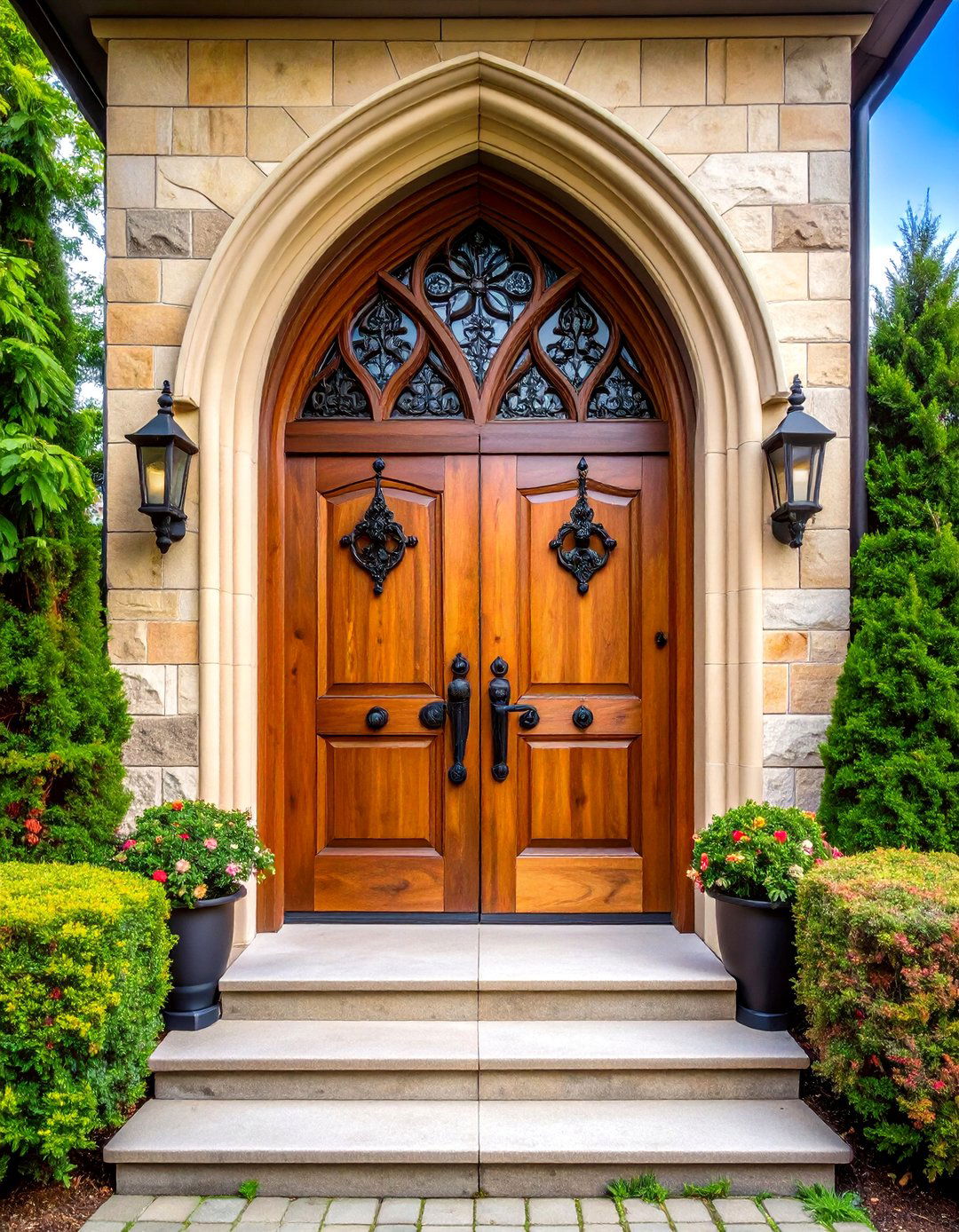
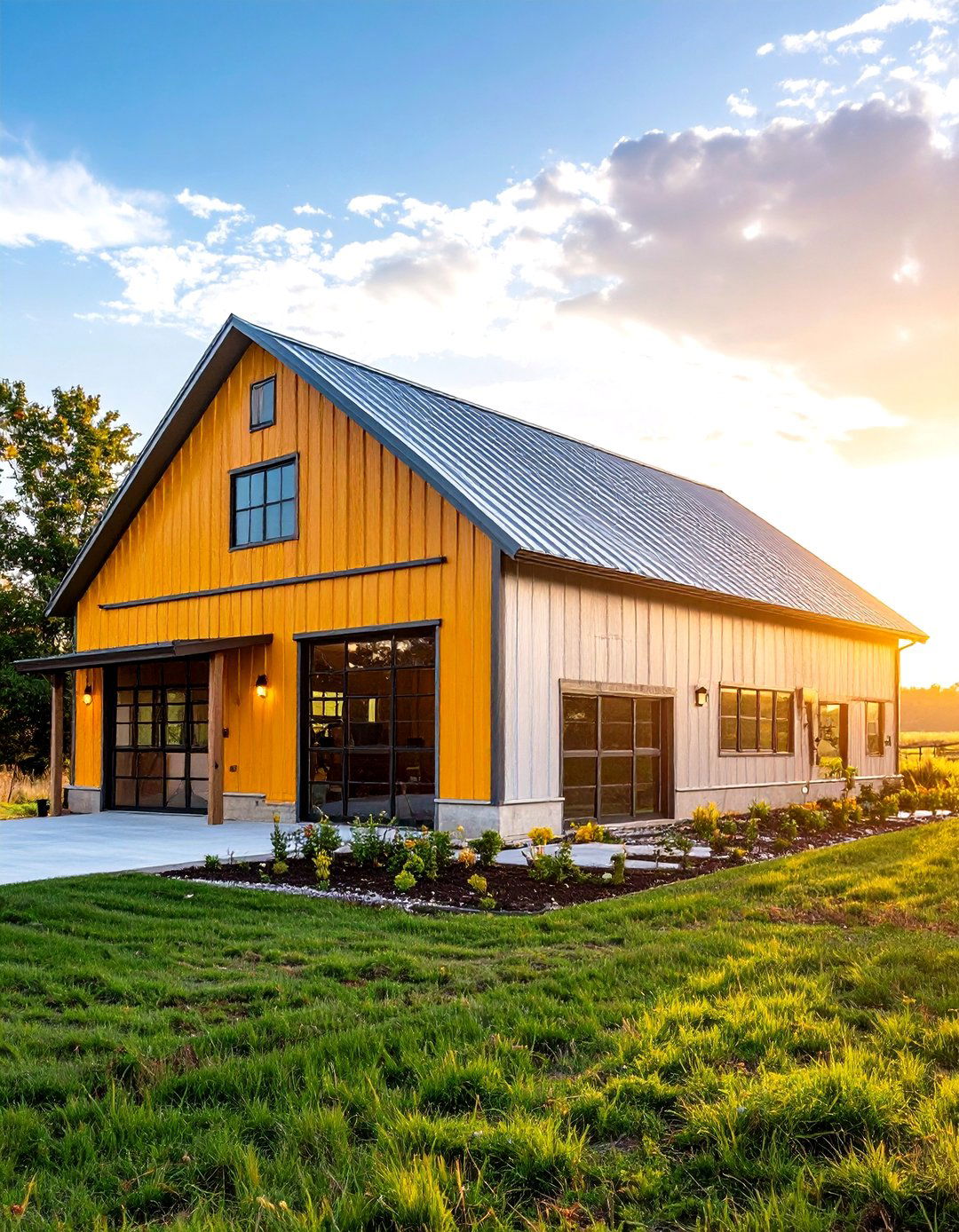
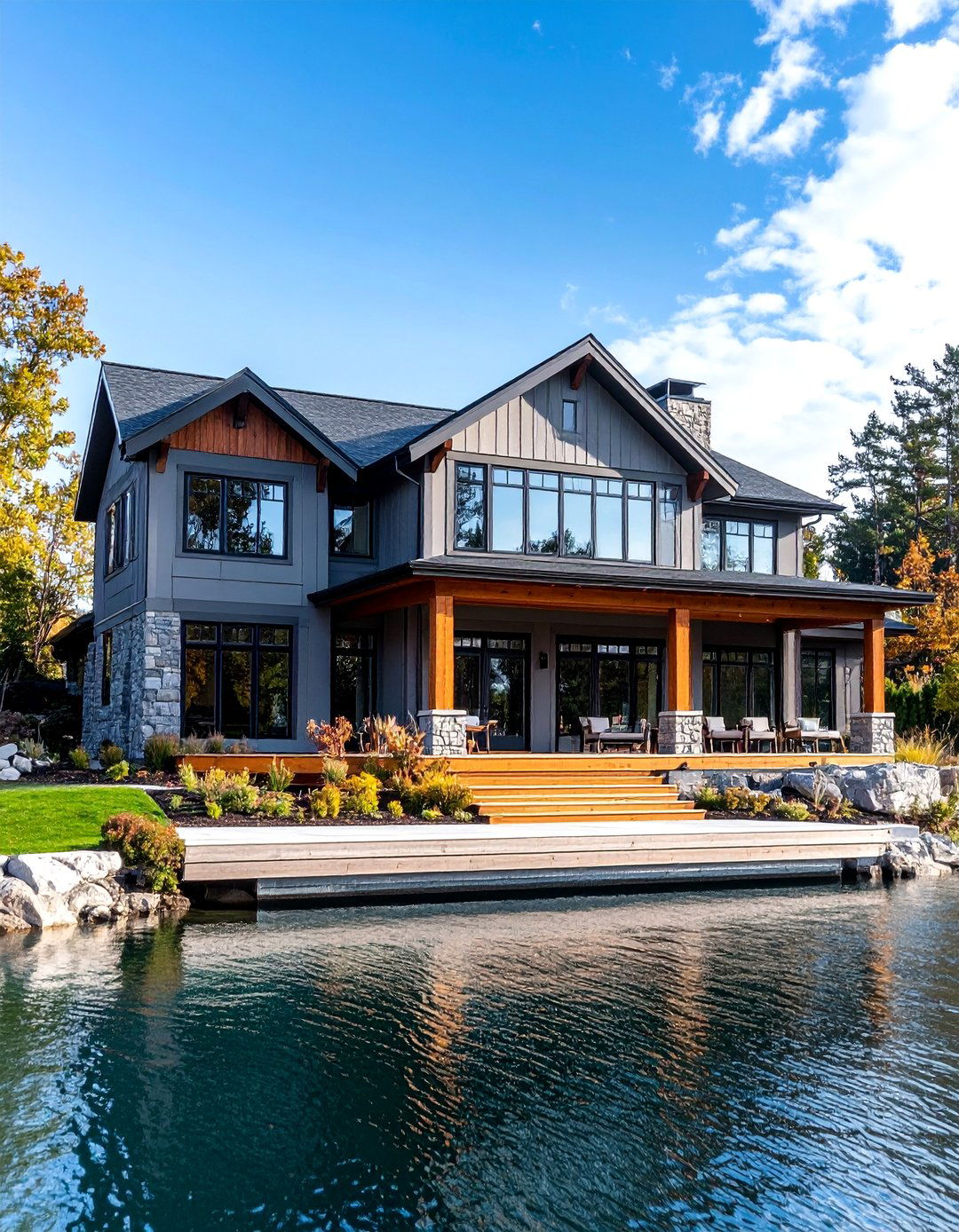
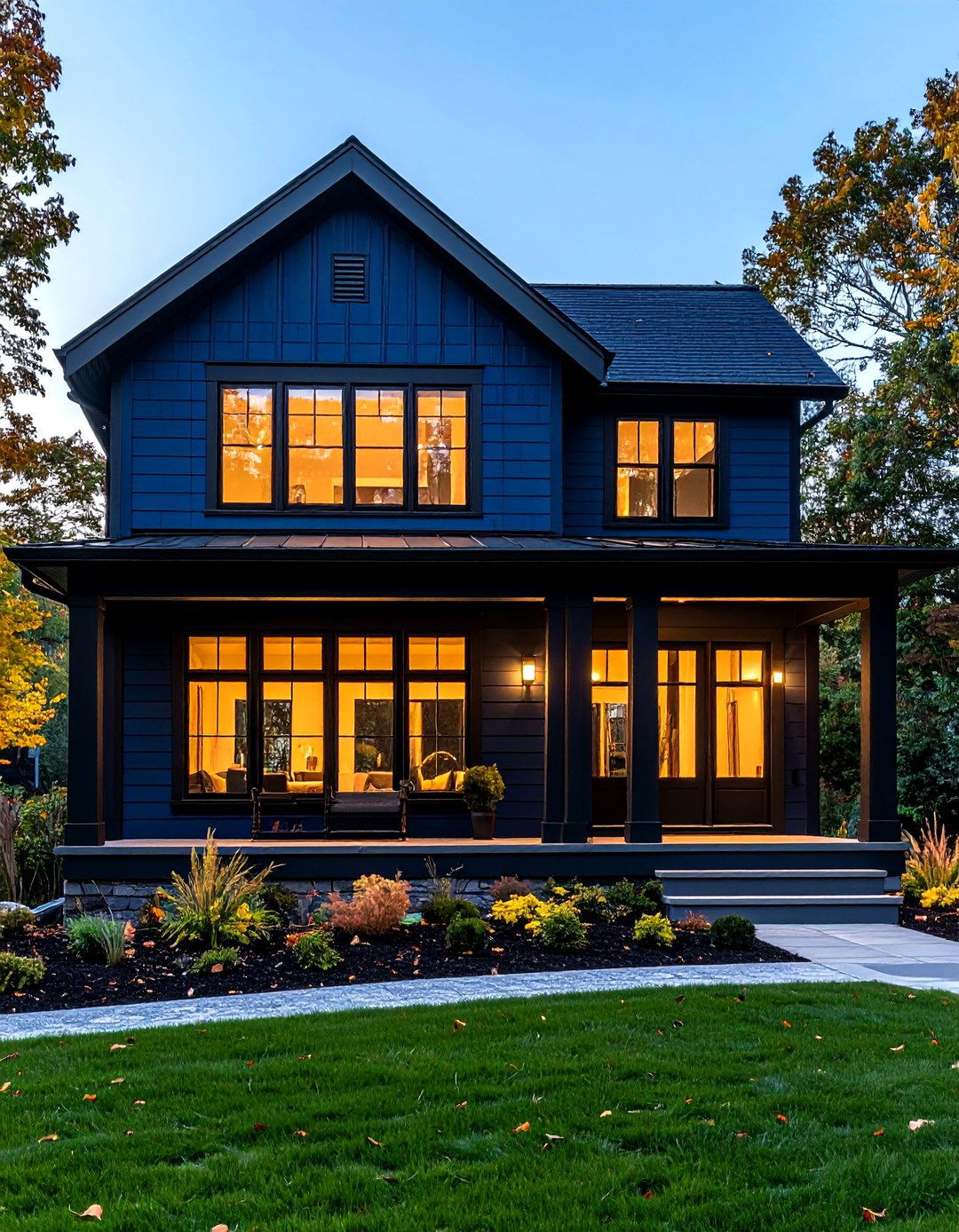
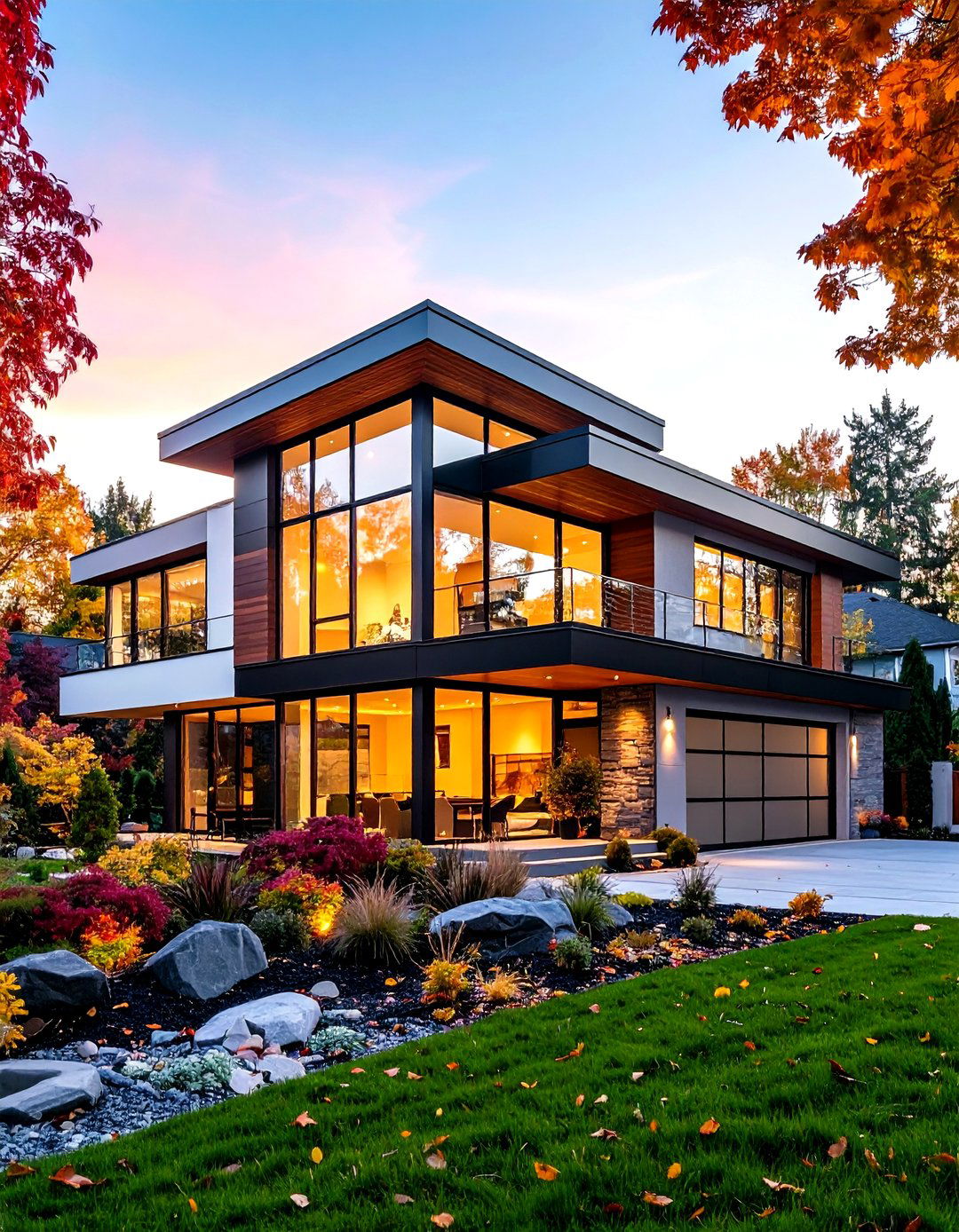
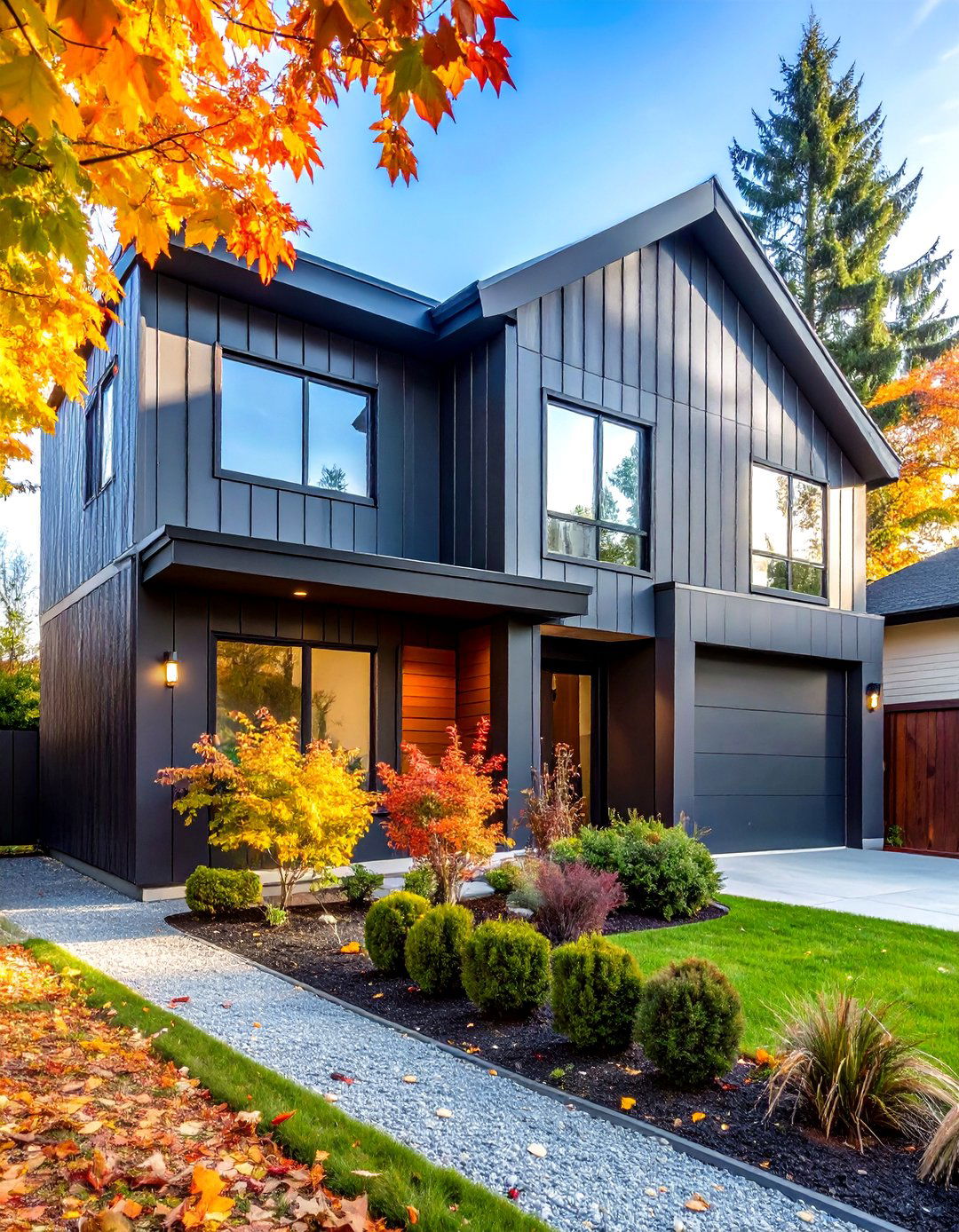
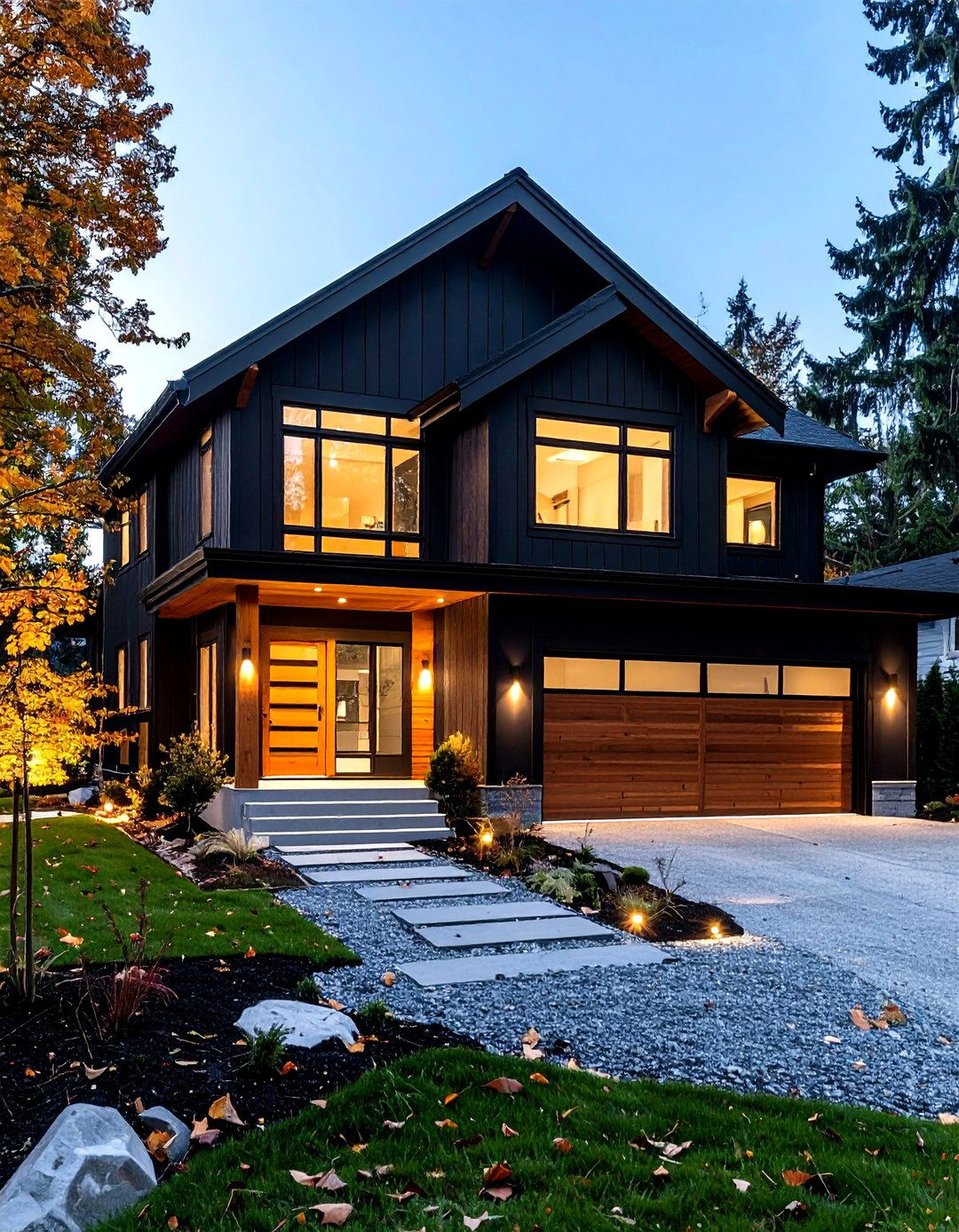
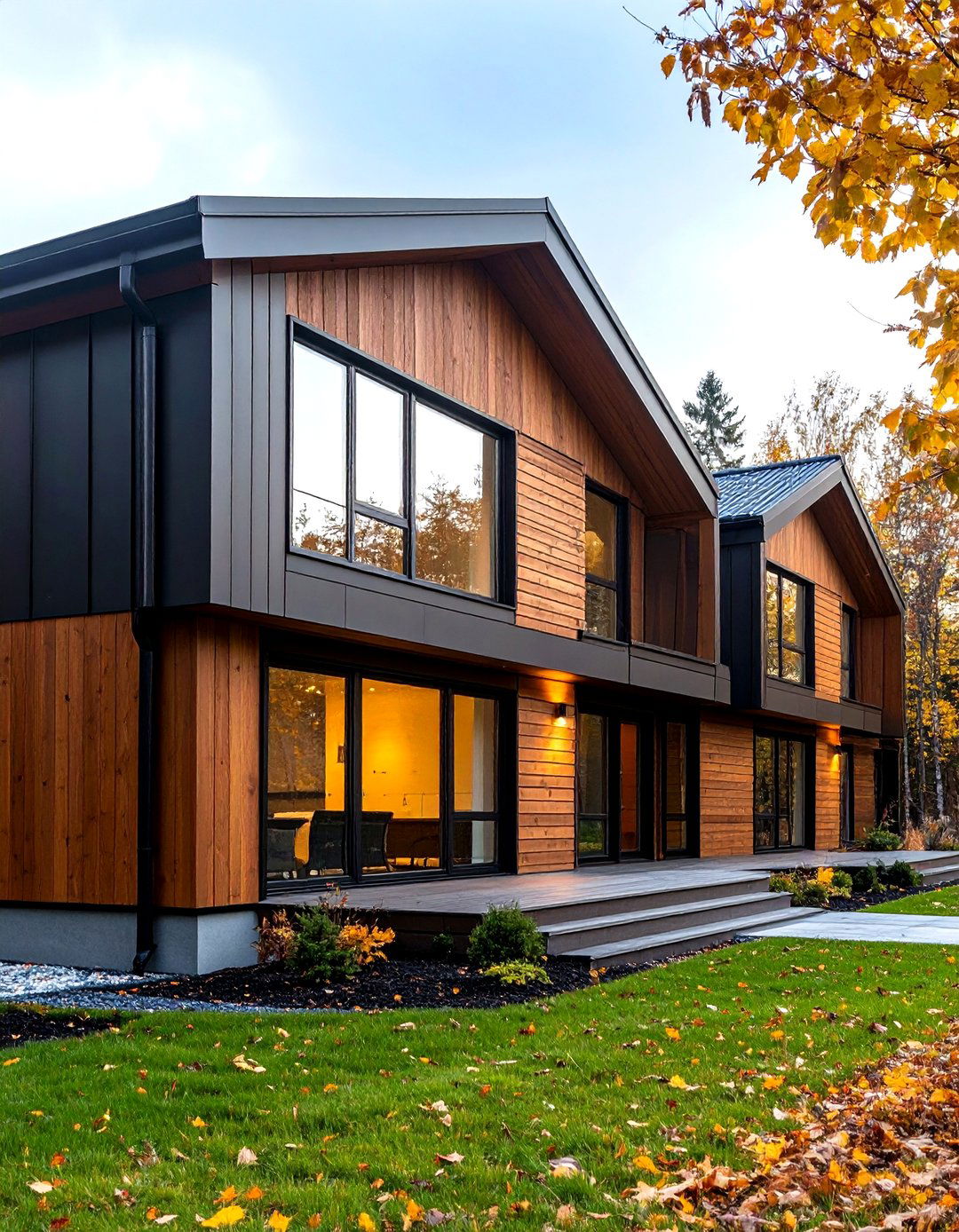
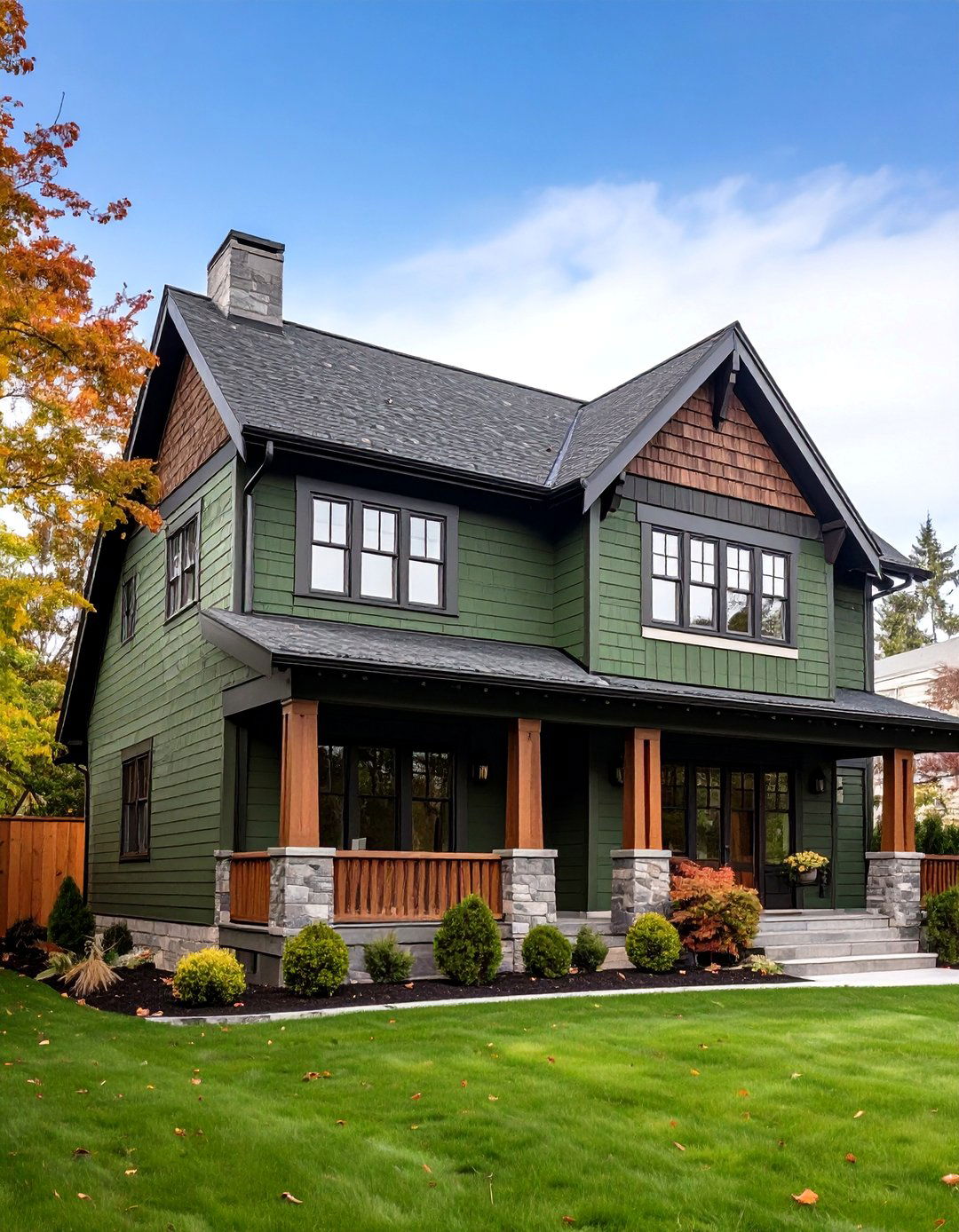
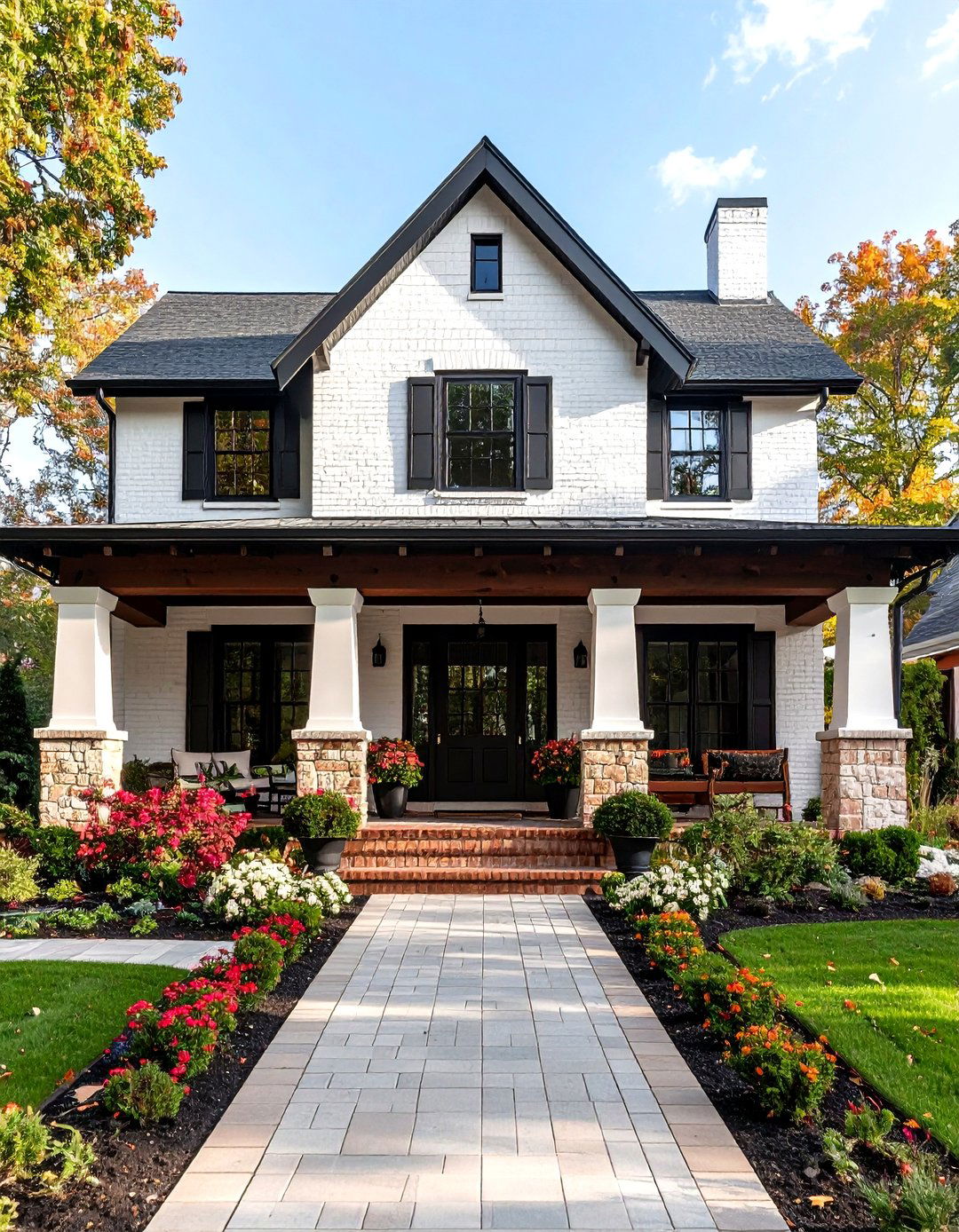
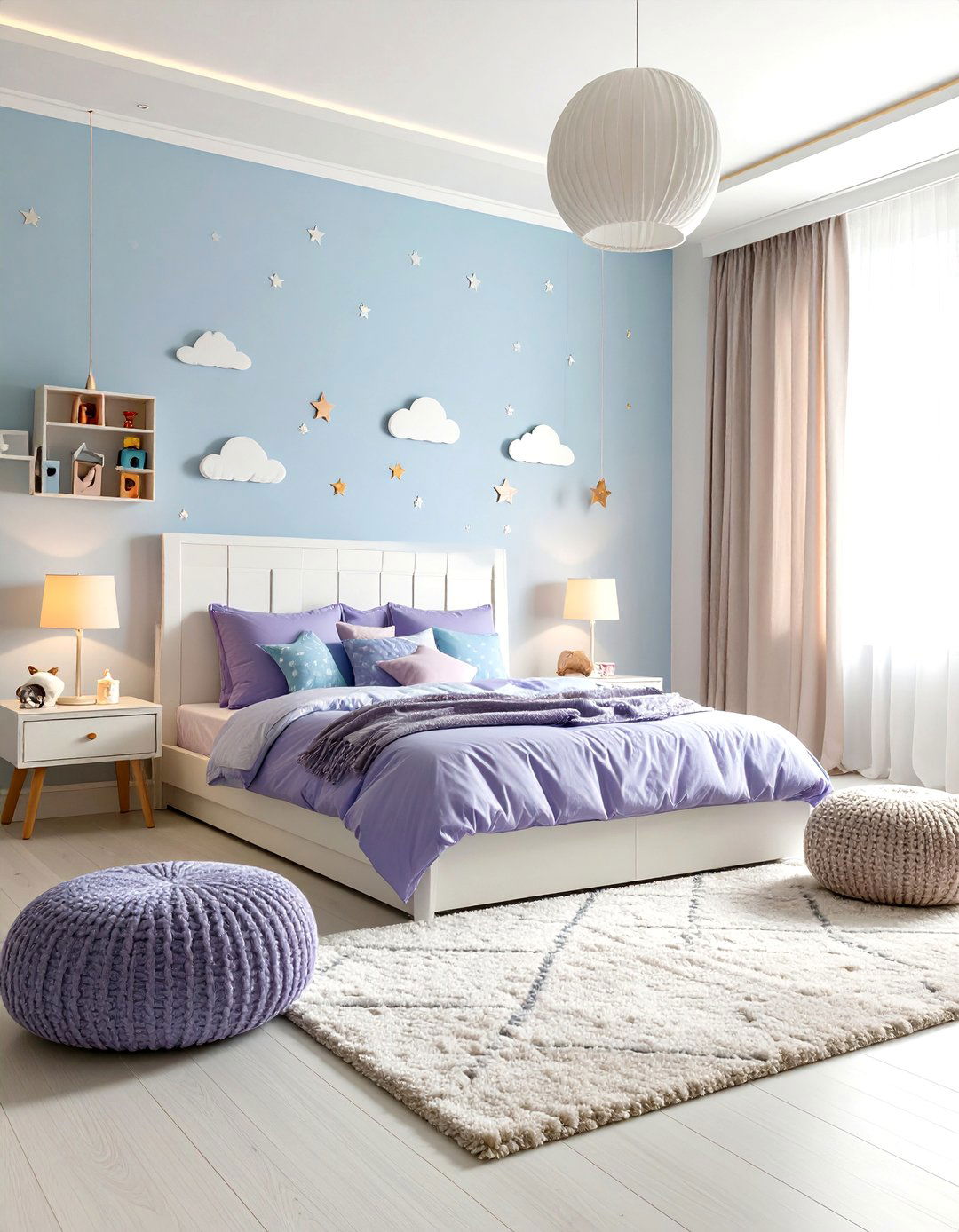
Leave a Reply